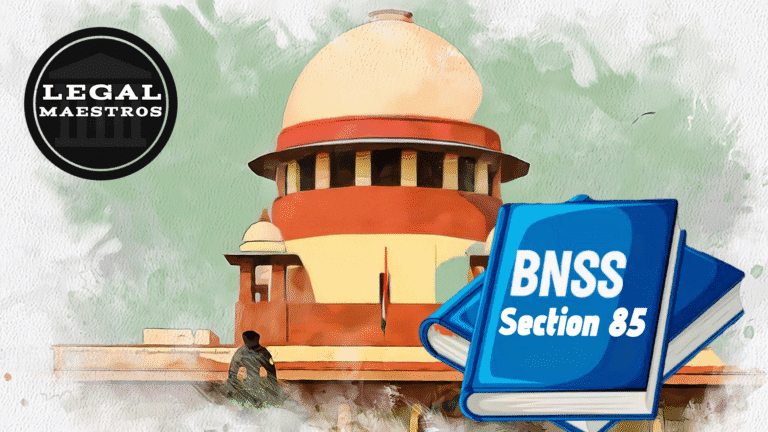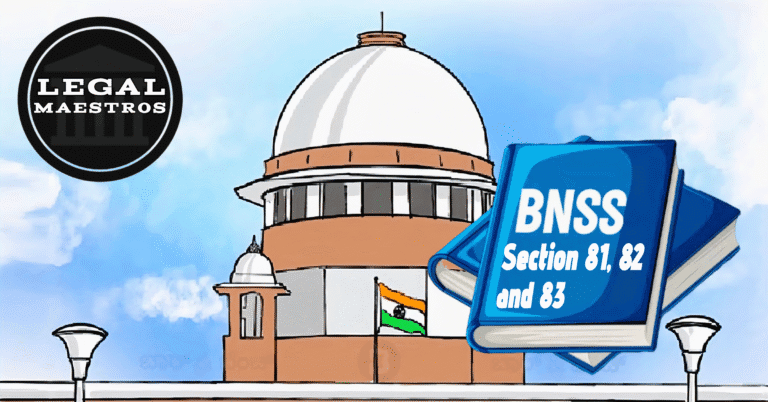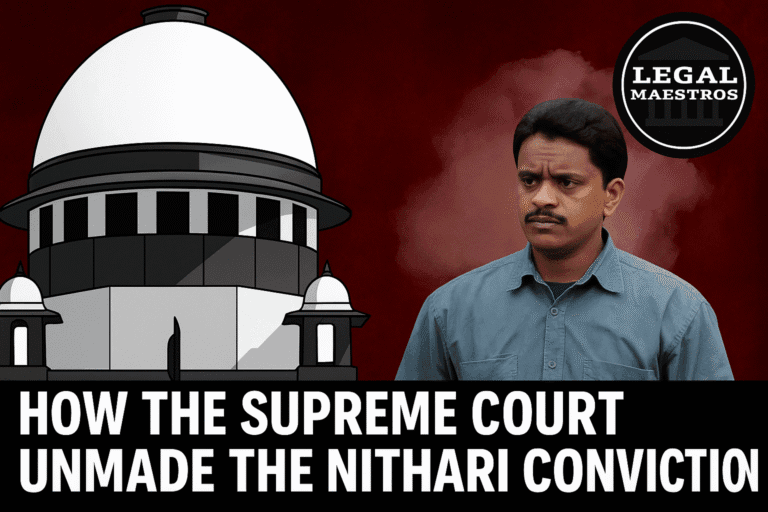
Section 75: Warrant May Be Directed to Any Person
Warrants can be directed by Magistrates using their authority.
In accordance with the provisions of Section 75(1) of the Bharatiya Nagarik Suraksha Sanhita, 2023, the Chief Judicial Magistrate or a Magistrate of the first class is the one who possesses the authority to issue a warrant for the arrest of any of the specified categories of individuals. Those who fall under this category include proclaimed offenders, escaped convicts, and anyone who is accused of a non-bailable offense but is attempting to avoid arrest. However, it is important to note that the warrant can be issued to any individual who is located within the Magistrate’s local authority, not simply law enforcement officers.
This indicates that the law permits trusted individuals who are not police officers to be empowered with the obligation of executing a warrant under certain situations. This is the case since the law allows for this. The flexibility and reach of the legal system are both increased as a result of this provision, particularly in rural or distant locations where the resources available to the police may be limited.
The Directed Person is responsible for carrying out the Warrant.
In subsection (2) of section 75, the duties of the individual to whom the warrant is directed are outlined. This person is required to first provide a written acknowledgment that they have received the warrant. An acknowledgment of the warrant is necessary because it creates a record in the court system that the individual has taken responsibility for the investigation.
For any queries or to publish an article or post or advertisement on our platform, do call at +91 6377460764 or email us at contact@legalmaestros.com.
Once the order has been obtained, the individual is compelled to carry out the execution of the warrant if the person against whom the warrant has been issued is discovered on land or property that is within his personal control. The landowner, the manager of the plant, or the building supervisor are all examples of individuals who might be in a position to seize an individual who is attempting to evade arrest and enters the premises.
After the arrest, the procedure
Once the individual specified in the warrant has been taken into custody, he is required to be turned over to the officer who is located closest to him, as stipulated by Section 75(3). After that, it is the responsibility of the police to bring the person who was arrested before a Magistrate who has authority over the case. In this way, the arrested individual is brought under the supervision of the court system in a timely manner, so preserving the equilibrium between the enforcement of rights and the protection of those rights.
On the other hand, if the authority that performed the arrest is able to obtain proper security from the person who was arrested, as permitted by Section 73, then they are permitted to continue accordingly, which adds an additional degree of procedural flexibility.
For any queries or to publish an article or post or advertisement on our platform, do call at +91 6377460764 or email us at contact@legalmaestros.com.
It is illustrated
Imagine a person who is hiding in a vast industrial estate and is accused of committing a major assault, which is a crime that cannot be released on bail. The Magistrate is of the opinion that the estate manager is trustworthy and possesses the necessary skills. An arrest warrant is issued to the management by him. When the manager discovers the suspect on the premises of the estate, he immediately places him under arrest, accepts the warrant, and then passes him over to the authorities in the area. For the purposes of Section 75, this is a legitimate and appropriate execution.
Section 76: Warrant Directed to Police Officer
The execution of warrants by other law enforcement officers
Another significant component of the execution of a warrant is addressed in Section 76, which is the situation in which a warrant is granted explicitly to a law enforcement official. In accordance with the provisions of the section, a warrant of this kind may also be executed by a different law enforcement officer if the initial officer includes his signature on the warrant.
This indicates that a warrant may initially be addressed to a certain police officer; nevertheless, in the event that it is required, that officer has the ability to delegate the execution of the order itself to another officer. The endorsement, also known as the transfer of responsibility, must be recorded on the warrant itself. This is the only requirement.
For any queries or to publish an article or post or advertisement on our platform, do call at +91 6377460764 or email us at contact@legalmaestros.com.
Having this option in place is absolutely necessary for the efficient running of police activities. When it comes to events that occur in the real world, the officer to whom a warrant was first issued can be inaccessible due to being occupied, injured, or otherwise unavailable. Instead of delaying the arrest, the method allows another officer who is competent to take over and finish the legal work in an effective manner.
It is illustrated
Let us take into consideration a scenario in which Inspector Singh is issued a warrant for the arrest of a criminal who is considered to be wanted. Nevertheless, during the process of carrying out the warrant, he is summoned away to attend to an emergency in a different district. The name of Sub-Inspector Khan is endorsed on the warrant from the perspective of Inspector Singh. Following that, Sub-Inspector Khan makes the arrest in a manner that is both lawful and effective, using the authority that was granted to him by the endorsement. In accordance with Section 76, this procedure is not only legal but also feasible.
Section 77: Notification of Substance of Warrant
Duties to Perform While Carrying Out a Warrant
A crucial protocol that must be followed during the execution of any warrant is outlined in Section 77 of the Bharatiya Nagarik Suraksha Sanhita, 2023. This procedure must be followed by any authorized individual, no matter if it is a police officer or another person. The individual who is being arrested is required to be informed about the contents of the warrant by the officer or person who is making the execution of the order. If the individual who was arrested requests to see the warrant, it is required that it be presented to them.
For any queries or to publish an article or post or advertisement on our platform, do call at +91 6377460764 or email us at contact@legalmaestros.com.
Both the legal rights of persons and the procedure of arresting them are safeguarded by this rule, which provides transparency in the process. An individual has the fundamental right to be informed of the basis for their arrest, and this clause ensures that this principle is upheld.
The Explanation and the Significance
The utilization of power is prevented by this requirement. It ensures that arrests are not done arbitrarily or without informing the individual who is being detained of the legal reason that led to the identification of the subject. Additionally, it affords the individual who has been arrested the chance to formulate a legal response, make contact with a legal representative, or even contest the warrant in court if there are sufficient grounds for doing so.
Furthermore, if this method is not performed correctly, the arrest may be declared unlawful, and the officer or person who made the arrest may be held liable in court for their actions.
For any queries or to publish an article or post or advertisement on our platform, do call at +91 6377460764 or email us at contact@legalmaestros.com.
It is illustrated
Suppose a law enforcement officer goes to the residence of a person in order to make an arrest. As required by Section 77, the officer is obligated to advise the individual that there is a warrant issued against them, such as in the case of a theft that cannot be released on bail. If the individual makes a request to view the warrant, the officer is obligated to provide it to them. The arrest can be considered unlawful if the officer refuses to provide the warrant that was issued for the arrest.






![Research Assistantship @ Sahibnoor Singh Sindhu, [Remote; Stipend of Rs. 7.5k; Dec 2025 & Jan 2026]: Apply by Nov 14, 2025!](https://legalmaestros.com/wp-content/uploads/2025/11/Gemini_Generated_Image_s0k4u6s0k4u6s0k4-768x707.png)
![Karanjawala & Co Hiring Freshers for Legal Counsel [Immediate Joining; Full Time Position in Delhi]: Apply Now!](https://legalmaestros.com/wp-content/uploads/2025/11/Gemini_Generated_Image_52f8mg52f8mg52f8-768x711.png)